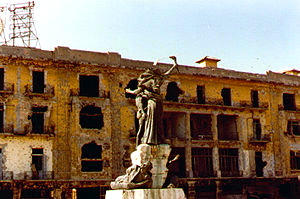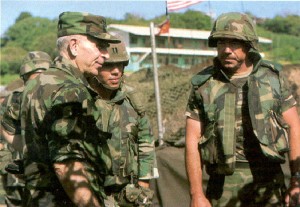Labanon & Grenard Wars

The Lebanon War 2006

Short documentary that examines the lives and thoughts of three members of Israel’s IDF reserve forces who served in the 2006 Lebanon War. Profoundly affected by their experiences, the three soldiers re-evaluate the reasons for going to war, and what exactly duty to one’s country means.
 The Martyr’s Square statue in Beirut, 1982, during the civil war
The Martyr’s Square statue in Beirut, 1982, during the civil war
The Lebanese Civil War (Arabic: الحرب الأهلية اللبنانية) was a multifaceted civil warin Lebanon. The war lasted from 1975 to 1990 and resulted in an estimated 150,000 to 230,000 fatalities. Another one million people (a quarter of the population) were wounded, and today approximately 350,000 people remain displaced within Lebanon. There was also a massexodus of almost one million people from Lebanon.
It has been argued that the antecedents of the war can be traced back to the conflicts and political compromises reached after the end of Lebanon’s administration by the Ottoman Empire. The Cold War had a powerful disintegrative effect on Lebanon, which was closely linked to the polarizationthat preceded the 1958 political crisis. The establishment of the state of Israeland the displacement of a hundred thousand Palestinian refugees to Lebanon (around 10% of the total population of the country) changed the demographics of Lebanon and provided a foundation for the long-term involvement of Lebanon in regional conflicts. By 1975, the presence of a foreign armed force in the form of the Palestinian Liberation Organization (PLO) guerrillas, who exercised a veto onLebanese politics, had a serious effect on Lebanon. The militarization of thePalestinian refugee population, with the arrival of the PLO guerrilla forces, sparked an arms race amongst the different Lebanese political factions.
After a short break in the fighting in 1976, due to Arab League mediation and Syrian intervention, Palestinian–Lebanese strife continued, with fighting primarily focused in south Lebanon, which had been occupied by the PLO since 1969, in contravention of the Cairo accords signed with theLebanese government. During the course of the fighting, alliances shifted rapidly and unpredictably: by the end of the war, nearly every party had allied with and subsequently betrayed every other party at least once. The 1980s were especially bleak: much of Beirut lay in ruins, as a result of the 1976 Karantina massacre carried out by the Lebanese Front (LF), the Syrian Army shelling of Christian neighborhoods in 1978 and 1981, and the Israeli invasion that evicted the PLO from the country.
The Taif Agreement of 1989 marked the beginning of the end of the fighting. In January of that year, a committee appointed by the Arab League, chaired by Kuwait and including Saudi Arabia, Algeria, and Morocco, began to formulate solutions to the conflict. However, on January 31, 1990, Lebanese Army forces clashed again with the LF. This brought fierce fighting to East Beirut, and although the LF made initial advances, the intra-Christian warfare eventually sapped the militia of most of its fighting strength. In August 1990, the Lebanese Parliament, which didn’t heed Michel Aoun‘s order to dissolve, and the new president agreed on constitutional amendments embodying some of the political reforms envisioned at Taif. On October 13, 1990, Syria launched its last major operation involving its army, air force and Lebanese allies (mainly the Lebanese Army, led by General Émile Lahoud) against Aoun’s stronghold around the presidential palace, where hundreds of Aoun supporters were killed. It then cleared out the last Aounist pockets, cementing its hold on the capital. Aoun fled to the French Embassy in Beirut, and later into exile in Paris.
On March 1991, parliament passed an amnesty law that pardoned all political crimes prior to its enactment. In May 1991, the militias (with the important exception of Hezbollah) were dissolved, and the Lebanese Armed Forces began to slowly rebuild themselves as Lebanon’s only major non-sectarian institution. Some violence still occurred. In late December 1991 a car bomb (estimated to carry 220 pounds of TNT) exploded in the Muslim neighborhood of Basta. At least thirty people were killed, and 120 wounded, including former Prime Minister Shafik Wazzan, who was riding in a bulletproof car. The Post-war occupation of the country by Syria was particularly politically disadvantageous to the Christian population as most of their leadership was driven into exile, or had been assassinated or jailed.
Independence, Revolution and US invasion: 1974-1983 – Independence
Four-star General Jack Vessey, chairman of the Joint Chiefs of Staff, in Grenada.
On 7 February 1974 Grenada became a fully independent state. Grenada continued to practise a modified Westminster parliamentary system based on the British model with a governor general appointed by and representing the British monarch (head of state) and a prime minister who is both leader of the majority party and the head of government. Eric Gairy was independent Grenada’s first prime minister serving from 1974 until his overthrow in 1979. Gairy won re-election in Grenada’s first general election as an independent state in 1976; however, the opposition New Jewel Movement refused to recognize the result, claiming the poll was fraudulent, and so began working towards the overthrow of the Gairy regime by revolutionary means. In 1976 St. George’s University was established.
The 1979 coup and revolutionary government
On March 13, 1979, the New Jewel Movement launched an armed revolution which removed Gairy, suspended the constitution, and established a People’s Revolutionary Government (PRG), headed by Maurice Bishop who declared himself prime minister. His Marxist-Leninist government established close ties with Cuba, Nicaragua, and other communist bloc countries. All political parties except for the New Jewel Movement were banned and no elections were held during the four years of PRG rule.
The 1983 coups
On 14 October 1983, a power struggle within the government resulted in the house arrest of Bishop at the order of his Deputy Prime Minister, Bernard Coard who became Head of Government. This coup resulted in demonstrations in various parts of the island which eventually led to Bishop being freed from arrest briefly, before being recaptured by the army and executed along with seven others, including members of the cabinet on 19 October 1983.
On 19 October 1983 the military under Hudson Austin took power in a second coup and formed a military government to run the country. A four-day total curfew was declared under which any civilian outside their home was subject to summary execution.
Invasion – Main article: Invasion of Grenada
A U.S.-Caribbean force invaded Grenada on October 25, 1983 in an action called Operation Urgent Fury, and swiftly defeated the Grenadan forces and their Cuban allies. During the fighting 45 Grenadians, 25 Cubans, and 19 Americans were killed. This action was taken in response to an appeal obtained from the governor general and to a request for assistance from the Organization of Eastern Caribbean States, without consulting the island’s head of state, Queen Elizabeth II, Commonwealth institutions or other usual diplomatic channels (as had been done in Anguilla). Furthermore, United States government military strategists feared that Soviet use of the island would enable the Soviet Union to project tactical power over the entire Caribbean region. U.S. citizens were evacuated, and constitutional government was resumed.
Seventeen members of the PRG and the PRA (army) were convicted by a court. Fourteen were sentenced to death for actions related to the overthrow of the Bishop government and the murder of several people including the Bishop. The sentences were eventually commuted to life imprisonment after an international campaign. Another three were sentenced to forty five years in prison. These seventeen have become known as the Grenada 17, and are the subject of an ongoing international campaign for their release. In October 2003 Amnesty International issued a report which stated that their trial had been a miscarriage of justice. The seventeen have protested their sentences consistently since 1983. After the invasion, United States gave $48.4 million in economic assistance to Grenada in 1984.


